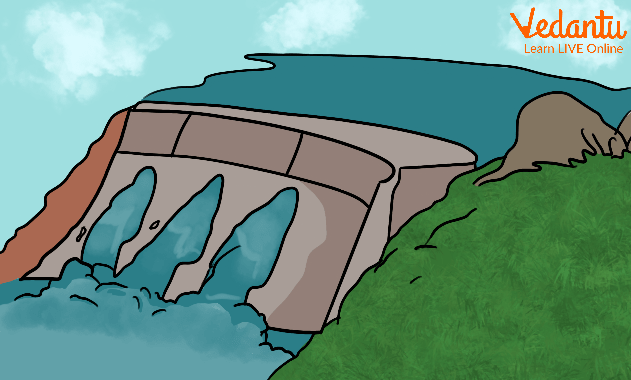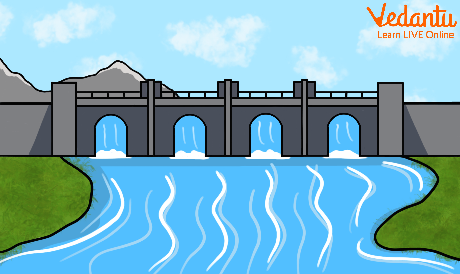




Why Dams Matter: Uses, Benefits, and Real-World Examples
Water dams have been around for centuries, so they are not new. Civilisations have used these great pieces of infrastructure. A dam is a wall that stops water from moving or sending it in a different direction. Beaver's dam works similarly to how big dams are made. Both must be high enough and strong enough to stop the water from moving forward.

Know About the Dam
Since the beginning of time, people worldwide have been building dams. Early Egyptians built a dam. The Romans built two dams in Spain.
Dams: A Brief History
The main reason why dams are built is to keep water in. Using obstructions, a dam stops or limits the flow of water or underground streams. In the history of dams, the first dam was built in ancient Egypt between 2950 BC and 2750 BC. Near Mesopotamia and the Middle East, archaeologists found a lot of old dams.
The world's big rivers, like the Tigris and Euphrates in the Middle East, the Ganges and Sindhu in the Indus Valley, and the Yangtze and Yellow Rivers in China, have ruins of dams. The construction and use of the first dams were easy. As the science of building dams got better, the dams got bigger, and the designs got more complicated and better.
Uses and Benefits of Dams
There are many great things about dams in India and other places. This also clarifies why governments put so much money into their buildings. Some advantages of building a dam include the following:
With the help of hydroelectric power, electricity is made at a steady rate.
To keep water from getting dirty.
The reservoir built behind it can also be used for irrigation or other things.
When needed, the lake is made sure to fill up with water.
They make it easier to store energy when water is let out of the dam to make electricity.
The electricity made by the dams cuts down on the number of greenhouse gases.
How to Construct a Dam?
A typical sequence for the Construction of dams is as follows:
Step 1: Dig a tunnel to divert the water and build coffer dams. The river being sent through the diversion tunnel is a major step that marks the end of this stage.
Step 2: Remove dirt from the foundation of the dam. Treat the foundation and fill joints. Dig up and move fill construction materials from where they are made, then put them in the dam embankment. The closing of the diversion tunnel marks the end of this stage and will be done to dig out the spillway.
Step 3: Finish the dam project's outlet works, spillway, and everything else.
Step 4: Engineers who design dams always pay much attention to how to handle floods while the dam is being built. Geologists must find clay, gravel, and rocks that can be used to build the dam wall before the dam's design can be finished.
Step 5: A dam is made by putting a block of earth, rock, or concrete across a stream or river to stop the water flow. Most dams are built to store water in a reservoir for irrigation and providing water to cities.
Hoover Dam Facts
The Hoover Dam facts are as follows:
While the dam was being built, no one was buried alive in the concrete.
When it was built, it cost more than any other engineering project in US history.
During World War II, the Germans planned to blow up the dam with bombs.
There is enough concrete in the dam to cover the whole country.
The concrete used to build the dam was cooled with the world's biggest cooler.
It helps keep three states running.
From the top of the dam, traffic is now redirected over America's second-highest bridge.
Interesting Facts About Dams

Dam
Dams provide 16 per cent of the world's power and irrigate food crops for 12 to 15 percent of the global population.
Dams have also been built for a smaller amount of water supply, flood protection, navigation, and tourism.
Although 80 per cent of the water kept in dams is utilised for electricity, they were primarily designed for agriculture.
Summary
Dams may fulfil one function or several purposes. Most dams, though, are built for more than one reason. Some dams, for instance, are built to make hydroelectric power or to water crops. Other barriers are built for recreation, to stop flooding, to help people get around on the river, and to give wildlife a place to live. The dams store water, which makes it easier for water to seep into the ground, change the groundwater resources, and help the region's economy grow.
FAQs on Top 10 Facts About Dams Every Student Should Know
1. What are some things experts must consider when building a dam?
When experts build a dam, they have to think about several things, including:
Absorption of the rock or soil around it
A water table
Earthquakes faults
Effects on wildlife, forests, places to live, and fisheries in rivers
Landslides and how stable a slope is
High water levels
Reservoir silting
2. What are different dam structures?
The following categories of dams may be distinguished according to their architectural makeup:
Arch dam
Gravity dam
Arch-gravity dam as the dam
Barrage dam
Embankment dam
Fixed-crest dam
Earthen embankment dam
Concrete-face rock-fill dam
Rock-fill embankment dam
3. How to make dams better for the environment?
A dam near a river can change the ecosystem of that body of water. Also, fish that swim through the turbines might get hurt or die. So, the experts need to figure out a way to stop fish from swimming through the turbines.
Another way to make the dam better for the environment is to use the currents. For this, engineers have to put turbines in rivers and streams in a way that makes electricity without stopping the flow of water. In this way, electricity is made naturally.









